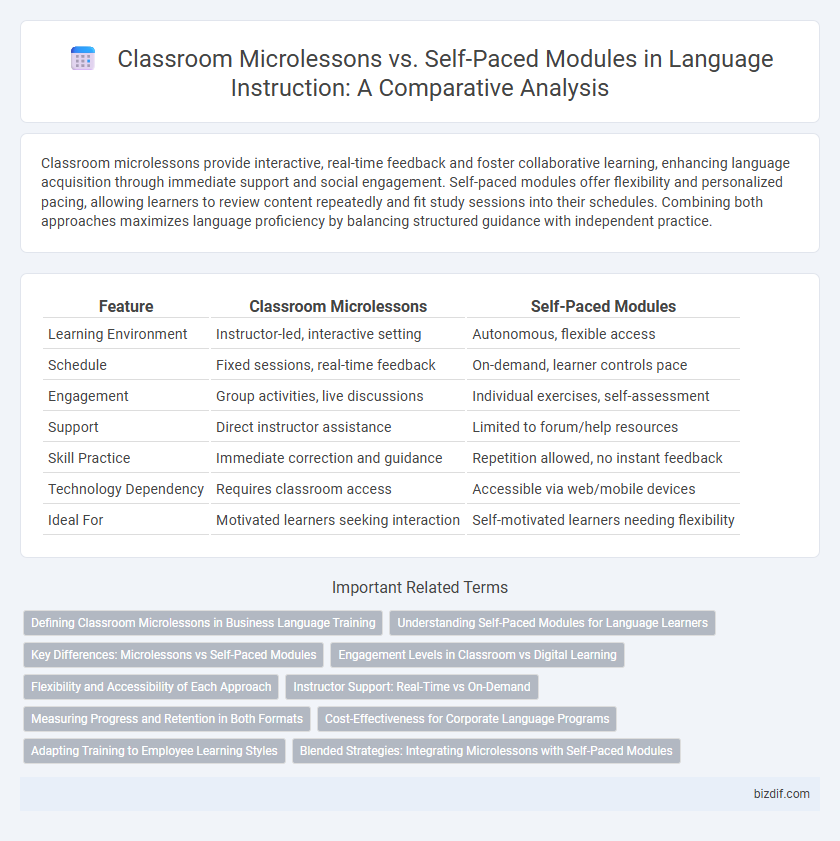Classroom microlessons provide interactive, real-time feedback and foster collaborative learning, enhancing language acquisition through immediate support and social engagement. Self-paced modules offer flexibility and personalized pacing, allowing learners to review content repeatedly and fit study sessions into their schedules. Combining both approaches maximizes language proficiency by balancing structured guidance with independent practice.
Table of Comparison
| Feature | Classroom Microlessons | Self-Paced Modules |
|---|---|---|
| Learning Environment | Instructor-led, interactive setting | Autonomous, flexible access |
| Schedule | Fixed sessions, real-time feedback | On-demand, learner controls pace |
| Engagement | Group activities, live discussions | Individual exercises, self-assessment |
| Support | Direct instructor assistance | Limited to forum/help resources |
| Skill Practice | Immediate correction and guidance | Repetition allowed, no instant feedback |
| Technology Dependency | Requires classroom access | Accessible via web/mobile devices |
| Ideal For | Motivated learners seeking interaction | Self-motivated learners needing flexibility |
Defining Classroom Microlessons in Business Language Training
Classroom microlessons in business language training are brief, focused instructional sessions designed to address specific language skills or topics within a live classroom environment. These microlessons prioritize interaction, immediate feedback, and real-time practice, enhancing learner engagement and retention. Unlike self-paced modules, they leverage instructor expertise and peer collaboration to accelerate practical language acquisition in professional contexts.
Understanding Self-Paced Modules for Language Learners
Self-paced modules empower language learners to control their study schedule and pace, enhancing personalized comprehension and retention. These modules often integrate multimedia resources and interactive exercises that adapt to individual proficiency levels, fostering autonomous learning. Analyzing learner data within these modules helps identify strengths and areas needing improvement, optimizing language acquisition outcomes.
Key Differences: Microlessons vs Self-Paced Modules
Classroom microlessons offer interactive, instructor-led experiences that facilitate real-time feedback and peer collaboration, enhancing learner engagement and immediate clarification of doubts. In contrast, self-paced modules provide flexible, asynchronous learning opportunities, allowing learners to progress at their own speed while accommodating diverse schedules and learning preferences. The key differences lie in the level of interactivity, pacing control, and immediacy of support provided to students.
Engagement Levels in Classroom vs Digital Learning
Classroom microlessons boost engagement through real-time interaction, immediate feedback, and social dynamics, fostering active participation. Self-paced modules offer flexibility but often face challenges in maintaining consistent learner motivation and focus without direct supervision. Engagement levels typically peak in structured classroom settings due to collaborative activities and instructor-led guidance.
Flexibility and Accessibility of Each Approach
Classroom microlessons offer structured interaction and immediate feedback, promoting engagement within a fixed schedule, ideal for learners seeking guided pacing. Self-paced modules provide maximum flexibility, allowing learners to access content anytime and tailor the learning experience to individual needs, enhancing accessibility for diverse schedules. Both approaches optimize language acquisition by balancing direct support with autonomous study, catering to varied learner preferences.
Instructor Support: Real-Time vs On-Demand
Classroom microlessons provide real-time instructor support, enabling immediate clarification and interactive feedback that enhance learner engagement and comprehension. Self-paced modules offer on-demand instructor assistance, allowing learners to access expert guidance at their convenience, which supports flexible learning schedules. The choice between these instructional formats impacts the immediacy and availability of personalized support critical for language acquisition.
Measuring Progress and Retention in Both Formats
Classroom microlessons enable real-time assessment through interactive activities and immediate feedback, fostering higher engagement and better short-term retention. Self-paced modules utilize built-in quizzes and automated tracking systems that allow learners to monitor progress independently, supporting flexible review but sometimes risking lower consistent retention. Comparative studies indicate that combining both formats with regular evaluations maximizes long-term language acquisition and measurable proficiency gains.
Cost-Effectiveness for Corporate Language Programs
Classroom microlessons often require higher upfront costs due to educator fees and scheduling logistics, whereas self-paced modules reduce expenses by leveraging scalable digital platforms. Corporate language programs benefit from self-paced modules by enabling employees to learn flexibly without disrupting work schedules, maximizing time efficiency and lowering overall training expenditures. Data from industry reports suggest self-paced language training can cut costs by up to 40% while maintaining comparable skill acquisition outcomes.
Adapting Training to Employee Learning Styles
Classroom microlessons offer interactive, real-time engagement tailored to kinesthetic and auditory learners, fostering immediate feedback and collaborative discussions. Self-paced modules cater to visual and read/write learners by allowing flexible access to multimedia content and the ability to review materials at an individualized speed. Adapting training to diverse employee learning styles enhances retention and skill acquisition by combining structured guidance with personalized learning paths.
Blended Strategies: Integrating Microlessons with Self-Paced Modules
Blended strategies combine classroom microlessons with self-paced modules to enhance language instruction by providing immediate interaction alongside flexible learning. Classroom microlessons deliver targeted, real-time practice and feedback, while self-paced modules offer learners personalized review opportunities and vocabulary reinforcement at their own speed. Integrating these methods maximizes engagement and retention through a balanced mix of structured guidance and autonomous study.
Classroom microlessons vs Self-paced modules Infographic

 bizdif.com
bizdif.com